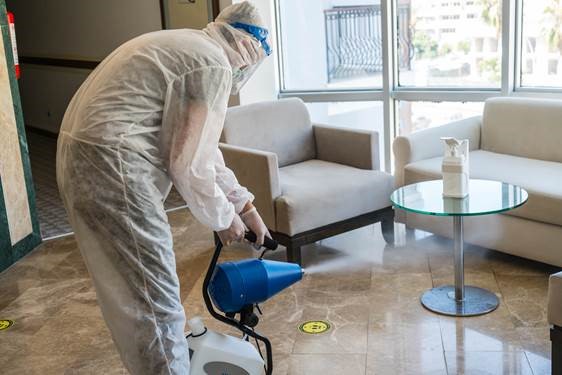
COVID-19 DISINFECTING: How to make the best decision
|
Basic cleaning is job one Whatever disinfecting process you ultimately choose, it will only be effective if the area is clean to begin with. All surfaces should be thoroughly cleaned with soap and water prior to being disinfected. Viruses and bacteria can easily be protected by dirt and other grime, requiring that surfaces be cleaned before any disinfectant is applied. Think of it as safeguarding your investment in disinfecting. Preparing surfaces by first cleaning them ensures the best possible protection for you, your staff and your visitors once disinfecting is complete. Manual Disinfection Process:
ULV (Ultra Low Volume) Disinfectant Fogging Mist: Fogging requires proper gear (mask and respirator), and should only be performed by industry professionals using specifically formulized disinfectant solutions. Any areas being fogged should be sufficiently aired out prior to reopening for general use. If at risk for continued exposure, fogging should be done regularly. There are different types of fogging machines: • Chemical foggers disperse a fine mist of disinfectant solution saturating the area. This is relatively fast, but harmful to breathe, requiring proper gear. Works well for the widest range of applications. • Vaporized hydrogen peroxide (VHP) is used in medical or sensitive manufacturing settings where safe rooms are required. Though very efficient, the room must be dehumidified first and does not work with biofilms. • Ozone fogging is a highly reactive compound produced at the point of use by passing air through a high-energy source such as UV light. The room must be humidified prior to service and must be cleared with fresh air after. • Chlorine dioxide (CIO2) treatment is a quite safe option as the gas breaks down into harmless salts. It is easy to produce and leaves no residue. The drawback is that it is an unstable compound which must be generated on location and has rigid temperature and humidity parameters that can make it unstable for some uses. • Ionization process passes air over ionizing tubes creating charged ions that seek out and neutralize naturally charged airborne microorganisms. This option produces long-lasting results and covers the largest surface area, but is less effective at treating all bacteria. Foggers are increasingly being used for a variety of areas as concerns over COVID-19 and other viral or bacterial transmissions continue to rise. For the most effective outcome, fogging should be performed in enclosed areas that can be sealed off for a minimum of two hours. Electrostatic Spraying: GMG Services DO NOT charge exorbitant amount for fogging. We use electrostatic sprayers and do not charge a premium for the service. We do not believe in profiting from a crisis situation. Whatever your disinfection requirements may be, we are equipped and ready to assist you at an affordable price. |
